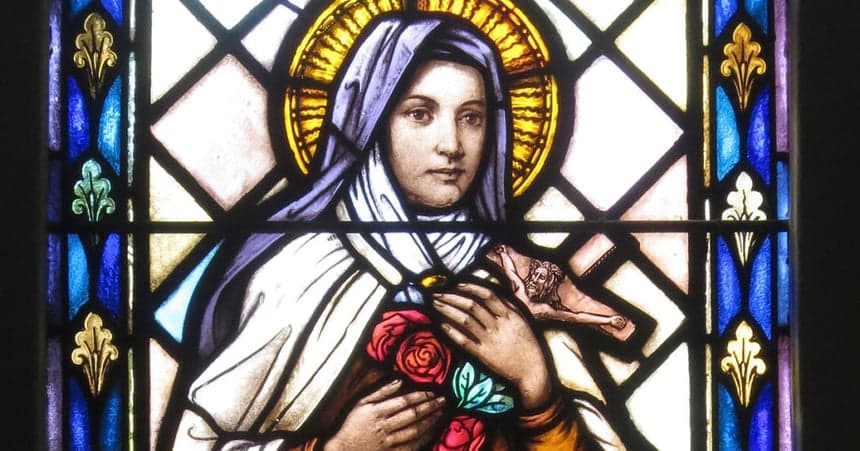St. Thérèse of Lisieux was at heart an anti-mystic who said that she did not want to see God on earth; she preferred to live in faith. That is what her short life was all about, a life of faith marked by an extraordinary love that she came to see was her vocation.
It was a vocation that reached out to others from a small Carmelite cloister in a small town in Normandy, France, until she was beloved throughout the world for the countless miracles worked through her intercession and for her autobiography, The Story of a Soul, which is really three books in one.
Chapters one to eight were written at the request of her prioress, her oldest sister Pauline, who had preceded Thérèse into Carmel. Pauline and Marie, Thérèse’s second-oldest sister and also a nun of Carmel, decided after the death of their beloved father to ask Thérèse to write down her memories of the early years of their family. Thérèse completed the manuscript in January, 1896, and gave it to Pauline.
The second part of the book is a letter to her sister Marie written at the latter’s request when Thérèse was already gravely ill with tuberculosis and knew she hadn’t long to live. In the letter she explains her particular vocation, her “Little Way” that has become so famous throughout the world.
The third manuscript was written at the request of Mother Marie de Gonzague, who had been prioress for seven three-year terms before Pauline, and who succeeded Pauline again after her term. Thérèse began her manuscript the very next morning, working two hours a day for as long as her strength allowed. The manuscript, understandably, is only about one-third as long as the first.
Gospel Life
When The Story of a Soul was published, just a year after Thérèse’s death, the arbitrary and domineering Mother Marie de Gonzague insisted the three manuscripts be combined so that the whole book would seem to be addressed to her—a move that hints at how Mother
Marie herself must have been a significant part of the spiritual martyrdom Thérèse suffered at Carmel.
This genesis and structure of the book helps us to understand why the early part of the book is full of sentimentality and is marked by a cloying preciousness of style. It was written for her sisters, Pauline and Marie, and was never intended for a wider audience. In the later writing she thought she was writing simply to give Mother Marie de Gonzague the information she needed for her obituary.
But the book did reach a wider audience, becoming an international bestseller that touched millions of lives. For, embedded in Thérèse’s almost schoolgirlish diction, is an extraordinary love story that readers intuitively grasped. Here was no plaster-pretty saint, no sweet little woman that her image became in countless holy cards and sentimental statues. Here was a soul on fire with love of God, a love that endured incredible pain and suffering, even while experiencing a terrifying dark night of the soul.
What, then, does St. Thérèse, the doctor of the church, teach us? Mainly, it is this: Christian mysticism is not an esoteric branch of theology or something separate from the gospel life.
It is the gospel life lived more intensely because of an intimate experience of God that has transformed the believer into open ground for the seed of God, a receptive womb for the impregnation of the Holy Spirit. The believer conceives and brings forth Christ anew in his or her own life.
One does not flee the daily humanness of life to ascend to some rarefied spiritual stratosphere or world of ideas or ecstasy. One waits like Mary, God’s mother, for the impregnation of the Holy Spirit, one receives and responds and brings forth in one’s life the God who is conceived in prayer, who grows in the womb of the soul, and is born into the world through one’s acts of virtue that derive from the self that has been transformed by conceiving, bearing and giving birth to God.









4 thoughts on “Meet the Mystics: St. Thérèse of Lisieux”
Thank you
During the time I was attending CCD for my Confirmation…the Sister teacher taught the class…
LITTLE FLOWER SHOW YOUR POWER.
Sister said that it was “the prayer that never fails ”
I am 69 years old and I remember it like yesterday.
In times of stress I call on MY LITTLE FLOWER.
I am rewarded with relief and help.
Lorraine
May the Lord Jesus put his hands on our eyes also, for then we too shall begin to look not at what is seen but at what is not seen. May he open the eyes that are concerned not with the present but with what is yet to come, may he unseal the heart’s vision, that we may gaze on God in the Spirit, through the same Lord, Jesus Christ, whose glory and power will endure throughout the unending succession of ages. (prayer of Origin, 185-254 AD)
Praise God for all his angels and saints. If only the world would realize that a saint is a sinner who keeps on trying and a sinner is a sinner who gives up trying. May God himself not seperate us from Himself in these trying times. May God’s will be done and may we all rest at ease for He is always in control although the devil may still have a license to test us all and may we be serious about the dangers of losing our souls. after all God comes like a thief in the night. God help us all and have mercy on our poor wretched souls. = In Jesus Holy Name with The Holy Spirit, Amen.